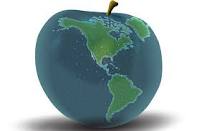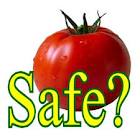 Globalization is having a profound impact on our cultures and societies.
Globalization is having a profound impact on our cultures and societies.
Our dietary habits are changing due to the globalization of food products. There’s a vast and expanding variety of foods we can purchase in stores and eating establishments.
International food and restaurant chains are expanding and growing.
Foodborne Illnesses Cross Borders
Most countries are cross-border trading food; from one part of the world to the far reaches of our planet. This cross-border trading has created concerns about food product and safety.
Foodborne illnesses like Escherichia coli O157:H7 (E. coli) caused large outbreaks in the past and present.
 In 1996 an outbreak of E. coli found in radish sprouts made over 6,000 Japanese schoolchildren sick.
In 1996 an outbreak of E. coli found in radish sprouts made over 6,000 Japanese schoolchildren sick.
E. coli has also been linked to outbreaks across the globe in uncooked ground beef, untreated water, and lettuce.
Salmonella outbreaks occur from tainted eggs and chicken.
Listeria monocytogenes outbreaks cause pregnant women to have miscarriages and stillbirths and are spread by processed meats and cheese.
Most people want to know that the food they purchase in restaurants, fairs, and stores is free from contamination, toxins, and chemical additives.
How Safe is Your Food?
We also want to know that our food is stored and prepared properly.
It’s particularly challenging to know whether the imported food we purchase is safe.
Note that the United States Department of Agriculture reported that over half of the shellfish and fish U.S. citizens consume is imported.
More than one-third of fresh fruits Americans purchase is imported, as well.
The food industry is growing and it is more difficult for governments and consumers to be confident their food is safe.
 Travelers can carry microorganisms from one geographical location to another and inadvertently carry foodborne diseases. Produce is sometimes grown in one location; contaminated with fecal matter or coated with pesticides and fertilizer residue, sprayed or injected with preservatives or coated with wax, then shipped overnight across international borders to far corners of the earth.
Travelers can carry microorganisms from one geographical location to another and inadvertently carry foodborne diseases. Produce is sometimes grown in one location; contaminated with fecal matter or coated with pesticides and fertilizer residue, sprayed or injected with preservatives or coated with wax, then shipped overnight across international borders to far corners of the earth.
For example in Pittsburgh, Pennsylvania, in 2003, hepatitis A virus caused deaths and hundreds of illnesses—the cause was fecally-contaminated green onions that were imported from Mexico.
The U.S. has a food supply that is the safest in the world; however every year 48 million Americans get foodborne disease—128,000 are hospitalized and 3,000 people die from contaminated food.
Healthy Habits and Safe Food Practices
Combating parasites, viruses, bacteria, and other contaminants in our food supply should be a high priority—especially when serving food to others at holiday gatherings, restaurants, and work.
Some healthy habits, safe food handling practices, and food safety measures can help you and your family avoid getting foodborne illnesses.
- Clean – Keep everything clean when preparing food. Wash your hands with soap and warm water for 20 seconds before and after preparing food. Wash food contact surfaces with hot, soapy water after preparing a food item and before moving onto the next item. Use a produce brush and rinse fruit and vegetables in cold water to remove dirt. Do not rinse raw meat or poultry before cooking in order to reduce the risk of spreading bacteria across the sink area and countertops.
 Separate — Avoid cross-contamination – don’t give bacteria the opportunity to spread from one food to another. Use one cutting board for raw meats, poultry, and fish and use another for raw fruits and vegetables. Keep raw meats, eggs, poultry, seafood and their juices away from foods you won’t cook.
Separate — Avoid cross-contamination – don’t give bacteria the opportunity to spread from one food to another. Use one cutting board for raw meats, poultry, and fish and use another for raw fruits and vegetables. Keep raw meats, eggs, poultry, seafood and their juices away from foods you won’t cook.
- Cook – Safely cooked foods need to reach a high enough internal temperature to kill bacteria. When reheating sauces, soups, and gravies bring them to a rolling boil before serving. Do not eat raw cookie dough—it may contain raw eggs.
- Chill – Harmful bacteria grows rapidly at room temperature so refrigerate food quickly. Refrigerate take-out and left-over food within two hours. Set your refrigerator to 40 degrees and your freezer to 0 degrees. Leftovers should be used within three or four days.
Hi George, Thank you for the enlightening post of Globalization of Food. It has been one of my passions in life to educate people about this. And now I bumped into your blog. I find this an important issue George because the “masses” don’t give it a second thought. “if it is in the store it is safe” is the mindset of most people.
I’ve been on this craze since the 90’s with the GMO process. In fact it is so important to me that I moved from NYC to Ithaca NY where there are local organic farms. I try to eat only local foods, but it can be difficult. The growth of food with human feces that you mentioned needs to be taught to the consumer. I try, but it falls on deaf ears.
It peeves me when I see Organic food from another country. It’s a no brainer that if you purchase an organic peach, it will be rotten in a few days. So what’s the deal with the organic food from other countries. Doesn’t anyone have common sense anymore??? Sorry for the rant, but please keep on writing.
Blessings,
Donna
Thank you for offering your insight Donna! I’m on your side.
I’ve been to Ithaca, NY–a fabulous place to live; however I share in your struggles to get quality organic food. I live in the Allegheny mountains of Coudersport, Pennsylvania; a few hours from you. In our little borough we are faced with poor choices of fruits and vegetables–they are predominately spoiled, brown, and non edible. The same applies for our fish and meat choices.
Nonetheless, we’ll keep doing our best, Donna! It’s good to know there are people like you that share my passion.
Take care…
Thanks again George for your post about a favorite subject —FOOD.
We have spent the past 50 years in various stages of Growing Food from small scale to large.
One thing we have emphasized is to BUY local and in season. Get to know your producer.
We can all enjoy the nutritious benefits of Fresh Produce without buying Import.
Root cellars and canning, when fresh local is available, WORKS well.
Keep up the Good work
Thanks for sharing your thoughts, Chuck! You’re absolutely right in buying local when possible!
In addition, I appreciate you offering your suggestion of canning. Canned goods are also important to have in case of potential disasters; power outages, storms, etc.
Chuck, thank you for the encouraging words, as well! Take care…
George,
This article really caught my attention. I learned a lot about food that I not only eat but prepare. I have to say I’m guilty of washing my meats. I wont be doing that anymore.
Thank you so much for this great article!
Tina
Thank you for taking the time to read and comment on this post, Tina! I’m glad I’m able to help…